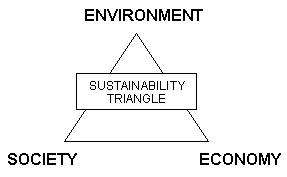|
Sustainability In Action
Section 1 - Sustainability Issues
It is important for designers to understand the broad cultural framework within which they work and in no area of the design field is this more important than sustainable design. Design decisions, like the decisions of consumers and politicians, are driven by values and values are formed in response to broad issues. This first section of the Sustainability Pack seeks to draw your attention to some of the areas that you need to think about. Section 1.1 - What is sustainability? According to the World Commission on Environment and Development, 1987, sustainability is understood to be "development that meets the needs of the present without compromising the ability of future generations to meet their own needs."
Sustainability is about responsibility, and has three main areas of focus; the environment, society and the economy. These can be represented in the Sustainability Triangle: 
As consumers, we have a lot of control over what is manufactured, and how it is manufactured. Each time we buy a product, we are effectively "electing" or "voting" for the company who has provided it. If we buy products from companies who are ethically irresponsible, e.g. companies that exploit their workers, or companies who are not concerned with the environment then we are "electing" un-sustainable companies. If we use our votes to support companies who produce sustainable products, such as free-range eggs or recycled paper, we will elect a group of companies who will re-invest in the planet, and share their success with us all. Environmental responsibility Environmental responsibility means ensuring that our actions and lifestyles do not have such a negative impact on the environment that the planet's resources are being used at un-sustainable rates - e.g. moderating our energy usage and method of generation to take advantage of renewable energies, and to maintain fossil fuel levels. Social responsibility Social responsibility means ensuring that other people's quality of life and human rights are not compromised to fulfil our expectations and demands - e.g. buying products and food which has been fairly traded, and manufactured in good conditions. Economic responsibility Economic responsibility means ensuring that there is an economic benefit both to the region from which the purchase came and to the region in which it is marketed. As designers, however, we have even more responsibility than consumers, and we have the potential to determine what and how people consume goods. This is eloquently expressed by Victor Papanek in his book Design for the Real World: The nature of a design problem is that it has many solutions. Generally, there is no "right" solution to these problems, but a range of solutions, which have different benefits, failures and consequences. As a designer, one must chose a solution that is better than the others - but this depends greatly on the designer's personal or imposed priorities."There are few professions more harmful than industrial design, but only a very few� by creating whole new species of permanent garbage to clutter up the landscape, and by choosing materials and processes that pollute the air we breath, designers have become a dangerous breed� In this age of mass production when everything must be planned and designed, design has become the most powerful tool with which man shapes his tools and environments (and, by extension, society and himself). This demands high social and moral responsibility from the designer."1. Sustainable Design problems also have many solutions - but in addition to the usual areas of concern, sustainable design must also consider the social and environmental implications of the product during its entire lifespan - production, use and disposal. For example, a solution which improves the life span of a product may put people out of work by reducing the demand for replacement products. A solution which reduces cost of manufacture and of retail price may have negative implications on the working conditions in the place of manufacture. Designers have some control over consumers and have direct control over how products are manufactured, assembled, distributed, used and disposed of. It is the responsibility of the designer to specify the product's characteristics, and the time has come to start specifying sustainable qualities as central aspects of successful design. 1.Papanek, Victor (1972) Design for the Real World, Thames & Hudson, London 1985
|
|||||||||||||
Sustainability Issues
|
|||||||||||||
| � | |||||||||||||
Toolkit Index
|


